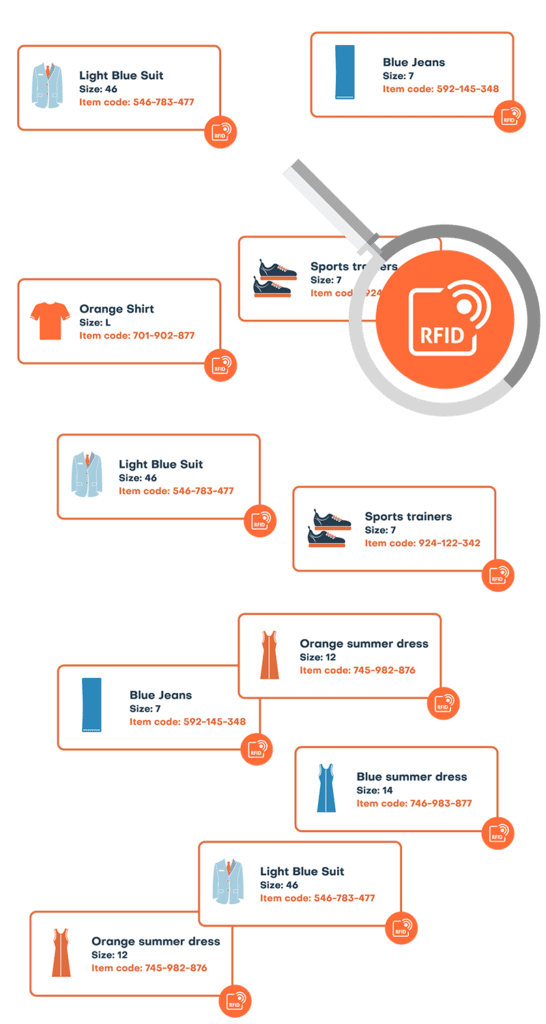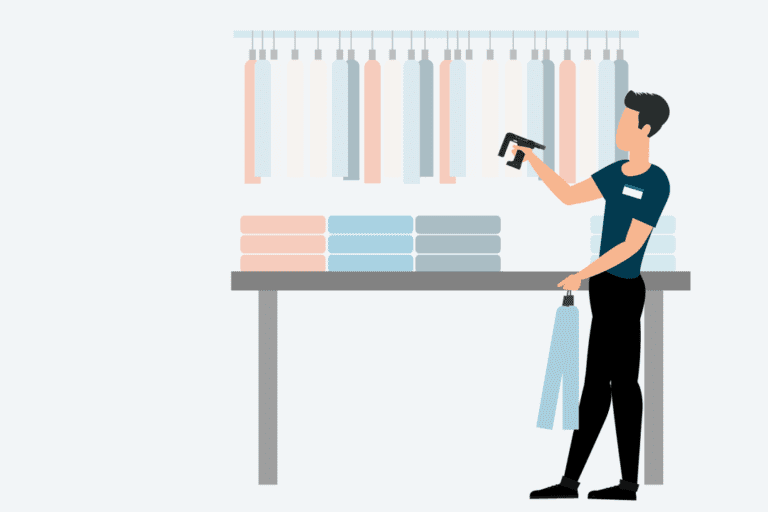Why inventory accuracy is so important (and where to start improving)
Fashion retail is hectic. Collections come and go. Store employees receive, refill, remove, and send items. Shoppers try products on and leave them in different places. Or they take things with them without paying at all.
The cure? Counting your inventory. Yet without RFID, inventory counts are only done once or twice a year, which declines heavily until the next count. And quite frankly, manual counts are just inaccurate because humans do them. This means that it is prone to error and will lead to inaccuracies. There is still a place for physical counting, for example, for your financial auditing.
Over time, these inaccuracies build up to the point that retailers can only partially trust their stock data...
In fact, retailers that don't use RFID have a stock accuracy between 65% and 75%.
What does this number mean? It means that, in one-third of the cases, you don't know what your inventory exactly is - or if it's even there.
As we will learn, this level of inaccurate stock data leads to products simply not being available in the store for the shopper to buy.
However, the consequences of low stock accuracy go much further than lost sales. It also leads to the following:

Order cancelations
Often orders are allocated to stores. If the stock data from those stores are only correct two-thirds of the time, that means one-third of the orders are canceled because the right product isn’t there.

Inefficient operations
Low stock accuracy also leads to wasted time in searching, allocating, and sending stock. It also leads to inflexible processes where inventory is managed separately for each retail channel, like stores, e-com, or wholesale.

Dead stock and producing more than necessary
On a strategic scale, low stock accuracy means a retailer overstocks stores, leading to markdowns and lower margins. And this means that a retailer is producing much more than necessary to fulfill demand, which is unsustainable. Finding out how to prevent dead stock will have a great sustainability impact.
Where do you start with implementing RFID?
Because the whole retail organization feels these pains, many retailers ask what the best place is to start improving their stock accuracy.
Our philosophy is that the physical retail store is the best place to start with RFID. We know that stores are much more 'chaotic' than DCs, so the most significant benefits of RFID are achieved in stores.
So, let's start with implementing RFID to increase our inventory accuracy.
What steps must you take to hit that 98% stock accuracy?
Before we start: what exactly do we mean by having accurate stock?
There are many ways to calculate the accuracy of your inventory. Nowadays, a statement like ‘we have an accuracy of 98%’ is widespread.
But what does that exactly mean? First, let’s analyze what we mean by ‘stock accuracy’ and then look closely at different methods to calculate stock accuracy. Finally, we will discuss the best definition to calculate stock accuracy that suits the fashion retail sector.
How to improve your inventory accuracy to more than 98%
Most retailers will first want to validate the business case for RFID, usually in a smaller amount of stores.
First of all, you need to tag your items with RFID labels. While source tagging is the most cost-effective way for retailers to tag, this is often a bridge too far if you are starting.
A good practice is to incorporate RFID tagging in existing labeling processes. Tagging happens most of the time in the DC or sometimes in the store. Either way, stores will receive items in the store with RFID labels on them.
After receiving these items, it is time to count. Counting is done by store staff using a handheld reader and an app that can process the RFID data coming in.
In just one hour, one staff member can count an average of 10.000 items.
The power of RFID
Luckily, stock takes with RFID only cost a fraction of the time compared to a manual store inventory count. In just one hour, one staff member can count an average of 10,000 items.
After the count
When the count is done, you compare the result of the RFID count ('what you actually had') to the data in your stock management system, like an ERP system ('what you thought you had').
After the count, any differences are investigated. Here, it is essential to know two things. First, you need to know what is missing: which products and from which category. Secondly, you want to understand why certain items are missing so you can take appropriate actions to prevent it from happening again.
RFID and ERP
When the investigation is done, the result is an approved difference list. This list is then fed back to your ERP system. So, your ERP system now has the latest, accurate stock data with products that are in the store.
It is good to know that RFID does not replace your current ERP system; it only sends the system better data. And because your ERP system now works with better data, it will automatically follow up by sending better shipments to your stores.
Repeat this process for a few weeks, and you will hit your first milestone: increasing the store's stock accuracy to over 98%.
How to keep your accuracy levels high, even more efficiently
A weekly store count is still the most common way to keep your stock levels accurate. But more and more retailers are looking at RFID to enhance other store processes as well.
Besides stock counting, there are two common in-store processes in which RFID can be of help:
- Receiving incoming shipments
- The Point of Sale
Receiving incoming shipments with RFID
Receiving incoming shipments with RFID has two big benefits. First of all, it is a substantial operational efficiency driver. Store staff doesn’t need to check the shipments’ contents visually; they can scan the boxes in a matter of seconds. This not only saves a considerable amount of time but also serves as an extra check.
Secondly, verifying incoming shipments increases stock accuracy right at the start, as you don’t need to wait for the next cycle count to know what was in the shipment.
Using RFID at the point of sale
A weekly store count boosts stock accuracy to more than 98%. But having accurate stock data is not the end goal. Stock levels based on a store count done on Monday will still be quite accurate on a Tuesday morning. But they will be less accurate on a Saturday afternoon.
For a staff member looking for a pair of jeans in a specific size, it can be frustrating to see that this product should be available but was actually sold some days ago. Using RFID at your point of sale can increase your stock accuracy daily, again boosting your efficiency.

How to empower your stores to work with RFID
Implementing RFID in other processes aside, it all falls short unless one condition is met.
Your stores need to embrace RFID.
For RFID to work, you need to improve specific processes in the store. Store staff must be trained on these new processes and how to execute them. So if the process:
- is difficult to understand,
- complicated to execute and
- does not reward the store team for doing their job better, faster, or easier...
…then you can never fully realize the full potential of RFID.
Ask yourself this when introducing RFID to the stores: what's in it for them?
The power of RFID
Creating support for RFID is critical for retailers who are starting with RFID, as well as retailers well underway in their RFID journey.
As the foundation of RFID's success is determined in the store, every new staff member must be onboarded in your RFID strategy. Ultimately, these people hold the handheld reader to count your inventory, print missing labels, and scan incoming shipments.
The question to ask yourself when introducing RFID to the stores is this: what's in it for them?
Moving from a yearly to a weekly stock count can overwhelm stores if they are not educated about RFID or included in the implementation process.
How to motivate your store managers to work with RFID
The store manager is typically the deciding factor for endorsing RFID. We see two types of store managers in fashion retail: generalists and sales-focused store managers. Both types are eager to work with RFID if they are motivated - in the right way.

Generalists
A generalist sees the whole picture regarding store processes: from receiving to selling goods and every process in between.
Often, they immediately ‘get’ RFID. But they still need to involve their staff members. Clear expectations, guidelines, and procedures for RFID are helpful for generalists, and most like to know the bigger picture as well.

Sales-focused
These store managers are driven by results, revenue, and their sales numbers. Though they often see the benefits of RFID, they might need to be reminded that an administrative task such as counting stock is good for their sales (we will cover how RFID will increase sales in the next chapter).
Sales-focused store managers are often competitive as well. Use this to your advantage! For example, you can introduce internal competitions on which store has the highest accuracy or who can count the fastest.
Higher stock accuracy should lead to actions
As a last note, a high stock accuracy, in itself, doesn't change anything. High stock accuracy won't refill your sales floor, nor will it automatically make you sell more.
However, improving your stock accuracy is the first step towards increasing in-store product availability and boosting sales.
Counting inventory with RFID serves as a diagnostic tool. RFID will let you see where you need to take action: optimize your replenishment to stores, refine your refill process from stockroom to sales floor, or even use your store's stock as a source for online channels.
So what's the next step? What actions can you take to turn your newfound inventory insights into actual results?
Find out in chapter two: increasing in-store product availability to boost sales.
Don't miss these RFID use cases






